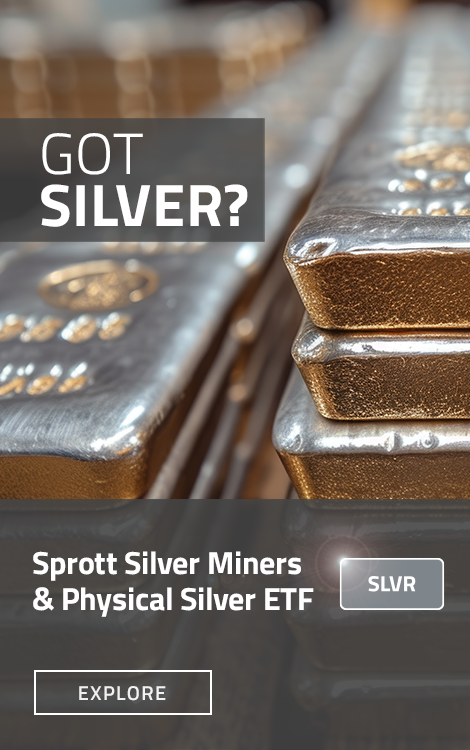Key Takeaways
- Silver Bull Market Gathers Strength: Silver has surged nearly 25% year-to-date in 2025, breaking past $35/oz, driven by structural deficits, industrial growth and renewed investor interest.
- Persistent Market Deficits: Global silver supply has not kept pace with demand for seven consecutive years. The cumulative shortfall has intensified upward price pressure.
- Industrial Demand Remains a Key Driver: Industrial demand accounts for 59% of usage for silver, which is essential to solar panels, EVs and consumer electronics.
- Potential for a “Silver Squeeze”: Freely traded silver inventories have been heavily diminished, and silver may be poised for sharp upside on even modest demand spikes.
Silver Breaks Through in the First Half
Silver bullion broke through the significant $35 per ounce resistance level early last month, reaching its highest price in a decade. Silver stood at approximately $38 at this writing, climbing closer to its most recent high of $48 in 2011 (and its all-time high of $49 posted in 1980).
Silver is an interesting beast given its two primary functions: monetary asset and industrial commodity. Both sides of this story have been quite positive for silver in 2025.
Along with gold, silver has been posting impressive gains. For the first six months of 2025, silver bullion gained 24.94%, following its 21.46% in 2024. We believe the catalysts for this silver bull market are a structural supply deficit, growing industrial demand and renewed investor interest, particularly among Asian and North American retail buyers of exchange traded products, coins and bars.
For the seventh consecutive year in 2025, the global silver market is likely to remain in deficit,1 putting upward pressure on prices. Supply is not keeping up with demand for silver.2 In fact, silver mine supply, as shown in Figure 3, has declined by 7% since 2016. Silver is crucial to the technology needed to meet rising global electricity demand, including solar power, EVs and electronics.
Figure 1. Silver’s Dynamic Uses
Source: The Silver Institute.
At the same time, silver is regaining prominence as a trusted safe-haven asset in today’s environment of increased geopolitical tensions, inflationary pressures and financial market instability. Historically, silver has served as a store of value in periods of crisis, much like gold, but with the added benefit of being significantly more affordable and accessible for retail investors. For example, India is the world’s largest importer of silver, and Indian buyers purchased record levels of both physical silver and silver ETFs in the first half of 2025.3
Figure 2. Gold and Silver Have Outperformed Other Asset Classes (1995-2025)

Silver Supply and Demand Imbalance Persists
Silver has been in a structural deficit since 2021. The cumulative shortfall for 2021-2025 totals almost 800 million ounces (25,000t).4 As shown in Figure 3, the electrical and electronics sector has been the biggest demand driver for silver usage, increasing 51% since 2016. This is not surprising given that silver is the most electrically conductive metal.
The electrical and electronics sector includes solar photovoltaics (PV); consumer electronics (phones, tablets, wearables, AI-related devices); automotive electronics (EVs, sensors, wiring); and power grid components and 5G networks. Solar PV-specific demand alone accounted for 17% of total silver demand in 2024, compared to 5.6% in 2015,5 growing at an annualized rate of 12.6%. The greatest push is coming from China, which increased its solar capacity by 45% in 2024. But despite record global solar installations, PV-specific demand remained relatively flat in 2024 due to aggressive “thrifting” by manufacturers as technological advances helped them reduce the amount of silver needed per panel.
Investment demand for silver will continue to be the wild card for the silver market balance. The rise of silver ETPs continues to impact silver demand significantly, as many silver ETPs are backed by actual silver stored in vaults, rendering it unavailable for industrial users. In the first half of 2025, global silver-backed ETPs experienced significant net inflows, reaching 95 million ounces.6 According to the Silver Institute, since 2019, more than 1.1 billion ounces (market balance plus ETPs) have been drawn from “available mobile inventory.”
Figure 3. Silver Demand Continues to Outpace Supply Growth (2016-2025)
Source: The Silver Institute, Metals Focus. The World Silver Survey 2025, April 2025.
Silver Squeeze Setup?
Silver remains undervalued relative to gold, opening it to significant upside potential. On average, gold has historically been priced at 67x the price of silver. With the current ratio at 91, silver is selling at a strong discount to gold (see Figure 4). Further, silver is mined at only 7:1 compared to gold.
In contrast to gold, silver is primarily influenced by retail investment demand, while gold is controlled by central banks and sovereign entities. The available inventory of freely traded silver has been heavily diminished, making the metal more sensitive to incremental buying. Small increases in demand could now lead to disproportionately large increases in price. With less silver available for open-market trading, investor positioning has become a more decisive force in price movements.
The current situation may be setting the stage for a possible “silver squeeze”: a situation when demand for physical silver surges suddenly, overwhelming available supply of freely traded or deliverable silver, and causing a sharp spike in silver prices.
Figure 4. Silver May Be Undervalued Compared to Gold (1980-2025)
*The gold/silver ratio is a measure that indicates how many ounces of silver are needed to purchase one ounce of gold. It is calculated by dividing the current spot price of gold by the current spot price of silver.
Source: Bloomberg as of 6/30/2025. The silver spot price is measured by the Silver Spot USD/Troy Ounce. You cannot invest directly in an index. Past performance is no guarantee of future results.
Looking Ahead
Silver and gold have historically rallied during periods of fiat currency debasement, inflation, falling interest rates, economic recoveries and rising geopolitical risks. We are in a similar period now.
Unlike fiat currencies, gold and silver cannot be printed at will and are more likely to retain their value over time. In past precious metals bull markets, silver’s rally has been ~2x as large as gold,7 on average. This past outperformance is due in part to silver’s smaller market size and higher volatility, which amplifies price movements, and silver’s dual role as both a monetary and industrial metal, which adds extra demand. In the past, silver's lower price relative to gold has attracted more retail investors and speculative capital, leading to sharper upside momentum.
With supply deficits deepening and demand intensifying across both industrial and investment channels, silver’s bull market appears well supported. We believe silver offers an attractive opportunity for investors seeking exposure to a hard asset with both growth and defensive qualities.
Figure 5: How Silver Performs in Precious Metals Bull Markets (1974-2025)
Note: A “bull market” refers to a financial market condition when prices are generally rising. A “bear market” refers to financial market conditions when prices are generally falling.
Source: Bloomberg. Data as of 03/31/2025. Silver reflects Silver Spot Price (XAG CURNCY). Gold reflects Gold Spot Price (GOLDS COMDTY). You cannot invest directly in an index. Past performance is no guarantee of future results.
Footnotes
| 1 | The Silver Institute, Metals Focus. The World Silver Survey 2025, April 2025. |
| 2 | The Silver Institute, Metals Focus. The World Silver Survey 2025, April 2025. |
| 3 | Reuters, Indian investors flock to silver as returns overtake those from gold. |
| 4 | The Silver Institute, Global Silver Market Forecast to Remain in a Sizeable Deficit in 2025, 1/29/2025. |
| 5 | The Silver Institute, Metals Focus. The World Silver Survey 2025, April 2025. |
| 6 | The Silver Institute, Metals Focus. The World Silver Survey 2025, April 2025. |
| 7 | Measures the percentage change between silver and gold’s respective lows and highs during each period. |
Investment Risks and Important Disclosure
Relative to other sectors, precious metals and natural resources investments have higher headline risk and are more sensitive to changes in economic data, political or regulatory events, and underlying commodity price fluctuations. Risks related to extraction, storage and liquidity should also be considered.
Gold and precious metals are referred to with terms of art like "store of value," "safe haven" and "safe asset." These terms should not be construed to guarantee any form of investment safety. While “safe” assets like gold, Treasuries, money market funds and cash generally do not carry a high risk of loss relative to other asset classes, any asset may lose value, which may involve the complete loss of invested principal.
Past performance is no guarantee of future results. You cannot invest directly in an index. Investments, commentary and opinions are unique and may not be reflective of any other Sprott entity or affiliate. Forward-looking language should not be construed as predictive. While third-party sources are believed to be reliable, Sprott makes no guarantee as to their accuracy or timeliness. This information does not constitute an offer or solicitation and may not be relied upon or considered to be the rendering of tax, legal, accounting or professional advice.








